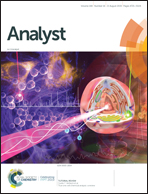Colorimetric sensor assay for discrimination of proteins based on exonuclease I-triggered aggregation of DNA-functionalized gold nanoparticles†
Abstract
Proteins play a key role in disease diagnosis, and protein discrimination is an important but difficult issue. Here, we report a novel strategy for improving protein discrimination through a facile colorimetric sensor array, which is based on DNA–gold nanoparticle (AuNP) conjugates manipulated by exonuclease I (Exo I). Different proteins exhibit diverse affinities toward the three DNAs, and the DNA–protein binding is resistant to the digestion of Exo I and protects the AuNPs from aggregation in high concentrations of NaCl media, forming distinct response patterns of the array. These response patterns as “fingerprints” can be acquired on the sensor array and then identified by linear discriminant analysis (LDA). The sensor array achieved the correct discrimination of 15 proteins at a 10 nM level in buffer solution and real serum samples. Also, the sensor array had the capability to discriminate individual proteins and the mixtures of them. Remarkably, the practicability of the sensor array was further confirmed by the identification of 35 unknown protein samples with 100% accuracy.



 Please wait while we load your content...
Please wait while we load your content...